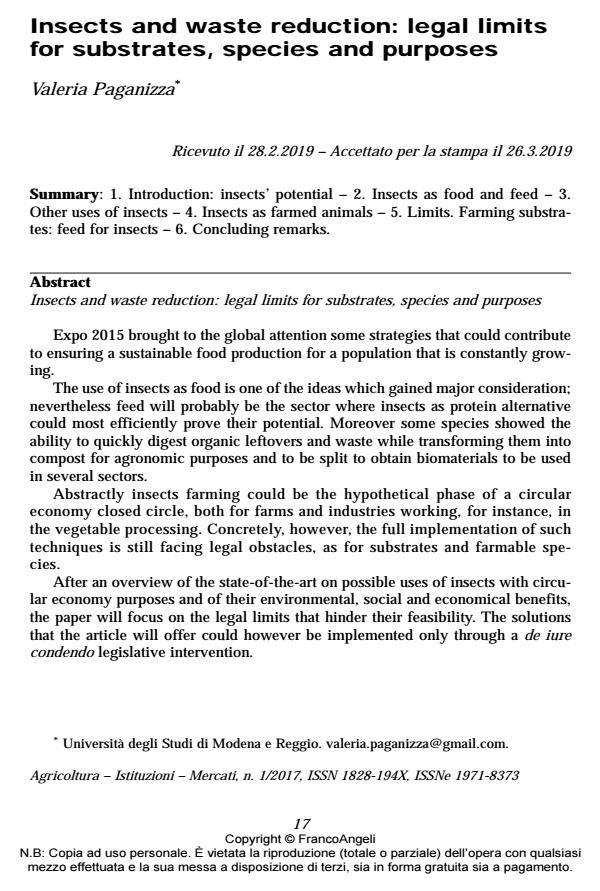Insects and waste reduction: legal limits for substrates, species and purposes
Titolo Rivista AGRICOLTURA ISTITUZIONI MERCATI
Autori/Curatori Valeria Paganizza
Anno di pubblicazione 2019 Fascicolo 2017/1
Lingua Inglese Numero pagine 16 P. 17-32 Dimensione file 51 KB
DOI 10.3280/AIM2017-001002
Il DOI è il codice a barre della proprietà intellettuale: per saperne di più
clicca qui
Qui sotto puoi vedere in anteprima la prima pagina di questo articolo.
Se questo articolo ti interessa, lo puoi acquistare (e scaricare in formato pdf) seguendo le facili indicazioni per acquistare il download credit. Acquista Download Credits per scaricare questo Articolo in formato PDF

FrancoAngeli è membro della Publishers International Linking Association, Inc (PILA)associazione indipendente e non profit per facilitare (attraverso i servizi tecnologici implementati da CrossRef.org) l’accesso degli studiosi ai contenuti digitali nelle pubblicazioni professionali e scientifiche
Expo 2015 brought to the global attention some strategies that could contribute to ensuring a sustainable food production for a population that is constantly growing. The use of insects as food is one of the ideas which gained major consideration; nevertheless feed will probably be the sector where insects as protein alternative could most efficiently prove their potential. Moreover some species showed the ability to quickly digest organic leftovers and waste while transforming them into compost for agronomic purposes and to be split to obtain biomaterials to be used in several sectors. Abstractly insects farming could be the hypothetical phase of a circular economy closed circle, both for farms and industries working, for instance, in the vegetable processing. Concretely, however, the full implementation of such techniques is still facing legal obstacles, as for substrates and farmable spe-cies. After an overview of the state-of-the-art on possible uses of insects with circular economy purposes and of their environmental, social and economical benefits, the paper will focus on the legal limits that hinder their feasibility. The solutions that the article will offer could however be implemented only through a de iure condendo legislative intervention.
Expo 2015 ha portato all’attenzione globale strategie che potrebbero contribuire a garantire un’alimentazione sostenibile per una popolazione in costante crescita. Se, tra le idee cui è stata dedicata preminente considerazione, vi è l’utilizzo di insetti nell’alimentazione umana, è forse la mangimistica il settore in cui l’allevamento di questi animali come fonti alternative di proteine potrà esprimere più efficacemente le proprie potenzialità. Alcune specie, inoltre, hanno dimostrato la capacità di digerire rapidamente scarti e rifiuti di origine organica trasformandoli in compost adatto all’impiego agronomico e di essere poi frazionate, per l’ottenimento di biomateriali destinati a diversi settori. Se astrattamente l’allevamento di questi animali potrebbe costituire l’ipotetica fase di un ciclo chiuso di economia circolare, sia all’interno di aziende agricole, sia in realtà industriali operanti, ad esempio, nella trasformazione di vegetali, concretamente, la piena realizzazione incontra ancora impedimenti di natura normativa in relazione a substrati e specie allevabili. Dopo un’analisi dello stato dell’arte dei possibili impieghi degli insetti con finalità di economia circolare e dei vantaggi ambientali, sociali ed economici da questi arrecati, l’articolo si concentrerà sui limiti normativi che ne ostacolano la fattibilità, ponendo in evidenza le criticità e suggerendo le soluzioni che solo un intervento legislativo de iure condendo sarà capace di attuare.
Parole chiave:Insetti, alimenti, mangimi, riduzione degli scarti, economia circolare.
Valeria Paganizza, Insects and waste reduction: legal limits for substrates, species and purposes in "AGRICOLTURA ISTITUZIONI MERCATI " 1/2017, pp 17-32, DOI: 10.3280/AIM2017-001002